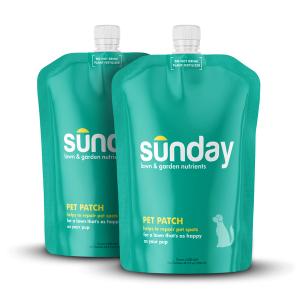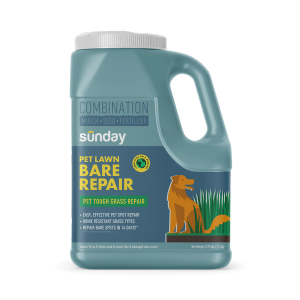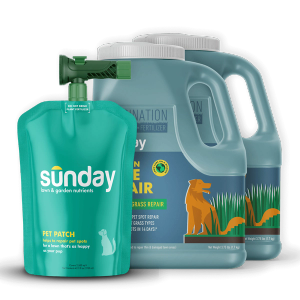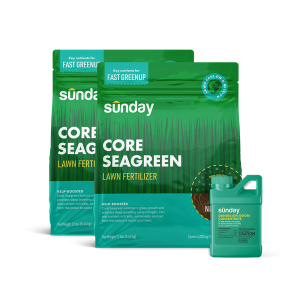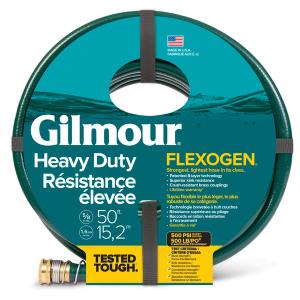Why fall lawn care matters
The shift from summer to fall is a golden opportunity for your lawn. As the air cools, your lawn's soil remains warm from summer, creating the perfect growing conditions for your grass roots to grow strong and absorb nutrients.
These conditions make fall the perfect time to care for your yard. Follow these four steps to build a winter-resilient lawn that comes back greener and healthier next spring.
Key takeaways for fall lawn care
- Reduce: Gradually lower your mowing height throughout the fall, aiming for a final cut of 2-3 inches to prevent winter diseases.
- Remove: Take advantage of the fall season to treat perennial weeds, as many are at their weakest point and are easier to control.
- Seed: Repair bare patches and overseed thinning lawn areas to build a thick, resilient lawn that naturally defends against spring weeds.
- Stop: After new seeds germinate, significantly reduce or stop watering for the season to conserve water and prepare the lawn for dormancy.
Your guide to fall lawn care
Reduce mowing
In the fall, your grass growth will naturally slow down. Your mowing routine should slow down with it. The goal is to gradually reduce your lawn's height to prepare it for winter.
Why cut lower? A shorter lawn (around 2-3 inches) is less likely to harbor pests or develop fungal diseases like snow mold, which can thrive in long, matted grass over winter months.
How to reduce mowing in the fall:
- Lower your mower blade incrementally over your last few mows. You should only trim off about 1/3 of the grass blade with each cut to avoid stressing the plant.
- When you notice very few clippings after mowing, you know you're nearing the final cut of the season.
Remove weeds
Fall is the best time of year to tackle weeds. Many common perennial lawn weeds are at their weakest point in their life cycle. They are busy transporting energy from their leaves down to their roots for winter storage, making them more vulnerable to being pulled or treated.
By getting rid of fall weeds now, you accomplish three things:
- You eliminate them before they can establish themselves over the winter.
- Sunday weed killers will be most effective right now! In other words, you'll use less product while eliminating more weeds.
- You clear the way for new grass seed to grow without competition for space, sunlight, or nutrients.
Sunday Tip:
Bonus? By treating fall weeds, you set the stage for a weed-free lawn in spring.
Seed your lawn
With your grass cut to the correct length and weeds out of the way, it's time for fall grass seeding. Fall provides the ideal growing conditions for new grass, making this a critical step for anyone with a cool-season lawn like Fescue or Kentucky Bluegrass.
- For bare patches: Repair bare spots by applying grass seed directly into exposed soil. Gently rake away any dead plant debris from the area first to help new seeds make good contact with the soil, which is critical for germination.
- For thinning lawns: If your lawn is looking a little sparse after the summer, overseeding can help thicken it up. This is one of the best natural defenses against spring weeds, as a dense, healthy lawn leaves no room for them to grow.
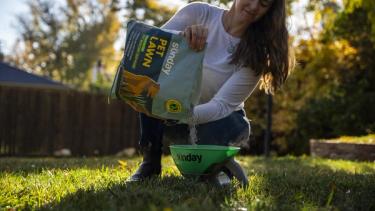
Seeding can be as simple as throwing a handful of seed on problem spots. Just spread it evenly and make sure it settles on the soil. Then, water daily as needed to keep the seeds and soil moist until the seeds germinate.
Sunday Tip:
If you have a warm-season lawn, fall can still be a great time to repair small lawn areas, particularly where you've removed weeds, with seed, sprigs, plugs, or sod. Read more warm-season planting tips.
Stop (or reduce) watering
The final step is simple: stop! After you've consistently seeded and watered your new seeds to ensure they germinate, it's time to prepare your lawn for winter dormancy.
Significantly reducing or stopping your irrigation for the season does three things:
- Helps your lawn harden off for the winter
- Conserves water and lowers your utility bills ($$$!)
- Protects your irrigation system (especially if you need to winterize it to prevent freeze damage)
Continue to water as needed in warmer climates, but reduce when able to, especially when it rains. In cooler climates, stop watering regularly when mowing ceases for the season. If you use an in-ground system, don't forget to winterize your irrigation system to avoid freeze damage!
Once you've completed these four steps, your work is likely done. Now, it's time to let nature take over, confident that you've given your lawn everything it needs to survive the winter and return greener and healthier in the spring.
Fall lawn care FAQs
What about fall fertilizer?
Fall lawn fertilizing is one of the most beneficial actions for your lawn in the fall. This guide focuses on the four core steps of physical lawn prep (mowing, weeding, seeding, and watering). Still, we highly recommend applying an iron- and nitrogen-rich fertilizer to fuel root growth and prepare your grass for winter.
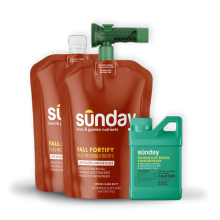
Fall to Winter Ready Lawn Kit
Grow a weed-free lawn this fall and protect your lawn from winter damage with our essential fall care kit, ideal for lawns up to 5,000 sq ft.
When should I start my fall lawn care routine?
The ideal time to begin is when the intense summer heat fades but before the first hard frost. For most regions, this window is from late August through September. This timing is critical because it gives new grass seed enough time to germinate and establish strong roots before winter arrives.
Why is mowing shorter in the fall so important?
Gradually reducing your mowing height to 2-3 inches for the final cut is a key part of fall lawn care. Shorter grass is less likely to become matted down by snow and ice, which reduces the risk of developing winter fungal diseases like snow mold. It's a simple step that helps protect your lawn all winter long.
Let's get growing
Our lawn engine uses satellite data to map out your lawn size and determine things like average rainfall, common weeds, and pest activity.
Cited sources
The Homeowner's Lawn Care and Water Quality Almanac. Cornell Extension.






